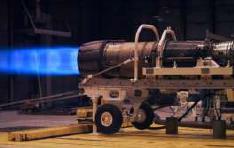
Operation Green Strike: the Promise of Biofuels
 The Navy is posed to sail a carrier strike group around Hawaii using a 50% biofuel blend during next summer’s Rim of the Pacific Exercise (RIMPAC). Industry minds, who met Thursday at a briefing held by PEW Charitable Trusts, referred to this effort as ‘Green Strike’, not to be confused with ‘the Great Green Fleet’ due to sail by 2016. Biofuel has been garnering attention from the media and Department of Defense as a next generation source of energy. Creating a commercialized biofuel market is one of the Navy and Air Force’s top priorities as both branches are seeking alternatives to offset petroleum use.
The Navy is posed to sail a carrier strike group around Hawaii using a 50% biofuel blend during next summer’s Rim of the Pacific Exercise (RIMPAC). Industry minds, who met Thursday at a briefing held by PEW Charitable Trusts, referred to this effort as ‘Green Strike’, not to be confused with ‘the Great Green Fleet’ due to sail by 2016. Biofuel has been garnering attention from the media and Department of Defense as a next generation source of energy. Creating a commercialized biofuel market is one of the Navy and Air Force’s top priorities as both branches are seeking alternatives to offset petroleum use.
Harrison Dillon, president of biotech company Solazyme, spoke at the event and shared what his company is doing to promote the biofuel industry. Solazyme started 9 years ago in San Francisco as a startup and is now a successful publicly traded company. It has developed an algae capable of turning biomass feedstock, such as corn, rendered animal fat, and the like, into fuel. The final chemical product acts just like crude oil. An AOL Energy article reports:
Solazyme is over half way through a 566,000 liter order for the military. In 2011 alone, it delivered 407,000 liters of fuel to the Navy and is working on additional contracts now.
Navy Secretary Ray Mabus has committed the Navy to a 50% reduction in the use of fossil fuels by 2020. The target includes nuclear but biofuels are a serious part of the future energy mix.
James Rekoske from UOP, a subsidiary of Honeywell, was also there. UOP invented 31 of the 36 processes used to refine crude oil and is now greatly contributing to progress on biofuels as well, specifically renewable jet fuel. In fact, their jet fuel was used in fueling the first transatlantic flight that ran on biofuel. The kicker to this is that airlines are interested in the technology as well. Like the DoD, their operations cost vary greatly depending on fuel price. According to Airlines for America, the fuel bill in 2010 was 300% greater than it was in 2000.
Former Senator John Warner, who was present, said “It is absolutely essential for the country to move forward on these programs.” Many of the speakers noted it took us a long time to get into our dependency on oil and it will take us a long time to get out of it. The progress that has been made on biofuels is just a start, but it is clear that this technology will allow us to diminish our reliance on oil.
Please also see our Biofuels Factsheet, available here.
Information on the recent Biofuels event ASP hosted available here.






[…] Dorsk: Operation Green Strike: the Promise of Biofuels […]
[…] Dorsk: Operation Green Strike: the Promise of Biofuels […]
Absent in this discussion are the critical challenges to drop-in or renewable fuels namely the cost recent estimates price Jet fuel at $26.00 per gallon, the availability of feed stocks Navy has tested and approved of JP8 from camelina, and the impact of production on “Green House Gases”. The Navy has tested and approved of DFM76 for ship 2500 gas turbines from animal fats. All this with no commercial market and a cost differential that will not compete with fossil fuels. The goals are admiral but are they realistic?
[…] Gen. Castellaw goes on to talk about biofuels for military use, a topic which ASP is heavily involved […]